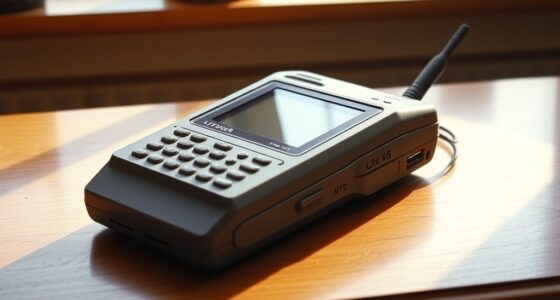The microwave was invented by accident when Percy Spencer, working on radar experiments, noticed a candy bar melting in his pocket. He realized electromagnetic waves could heat food quickly and efficiently. This unexpected discovery led to the development of the first microwave oven and future innovations in kitchen technology. If you keep exploring, you’ll uncover how this serendipitous event transformed cooking and impacted modern life in surprising ways.
Key Takeaways
- Percy Spencer discovered microwave heating accidentally when a candy bar melted in his pocket during radar experiments.
- The incident revealed that electromagnetic waves could transfer heat directly to food.
- This accidental event led to exploring microwave effects on food and the development of microwave oven technology.
- It transformed radar research into a practical appliance for quick food heating and convenience.
- The discovery prompted further innovations, evolving into modern microwave ovens with advanced features.
Percy Spencer’S Work With Radar Technology
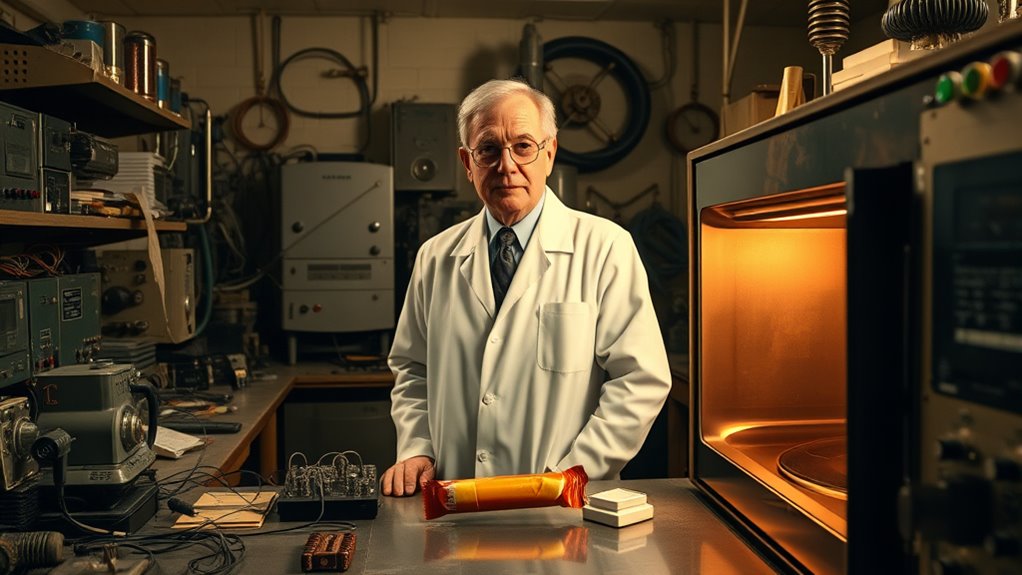
Percy Spencer’s work with radar technology laid the foundation for the accidental invention of the microwave oven. His understanding of material properties was essential, especially how different materials interact with electromagnetic waves. Spencer experimented with radar equipment, which used high-frequency electromagnetic waves to detect objects. He noticed that certain substances, like candy bars, would melt when exposed to these waves, revealing how electromagnetic energy transfers heat. This observation demonstrated that electromagnetic waves could directly heat food, unlike traditional methods that rely on conduction or convection. His knowledge of wave behavior and material properties led to exploring how microwave radiation could be harnessed for cooking. This insight sparked the idea that electromagnetic waves could produce rapid, efficient heating, ultimately leading to the development of the microwave oven. Additionally, advancements in AI security technologies are ensuring that modern microwave appliances remain safe from cyber threats.
The Unexpected Melting of the Candy Bar
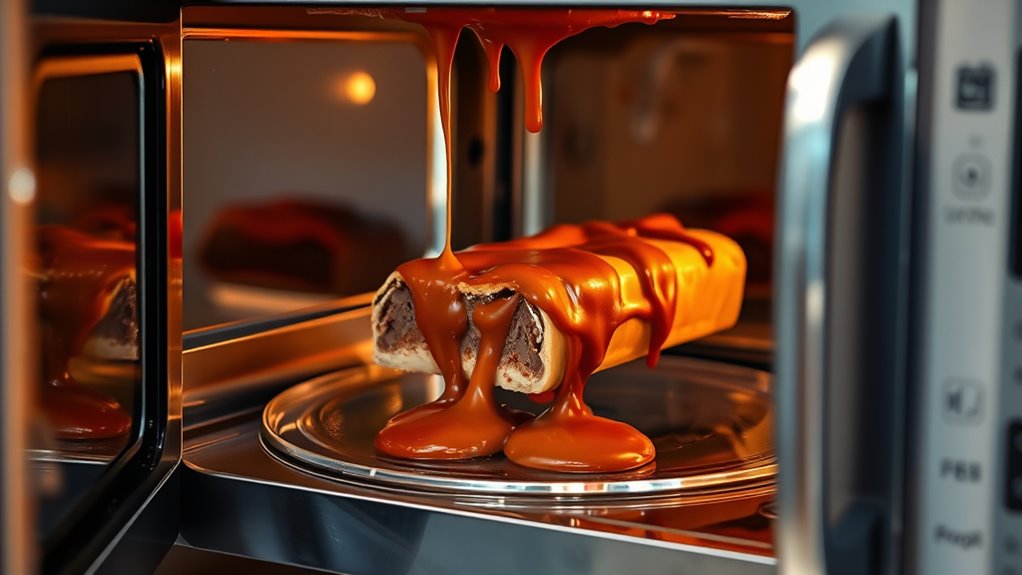
One of the most striking moments in Spencer’s experiments was when a simple candy bar in his pocket melted unexpectedly during a test with radar waves. This candy melting was the result of an accidental discovery that changed everything. You might imagine how surprised he was to see the candy turn gooey without any warning. This incident sparked curiosity about the effects of microwave energy on food. To illustrate, here’s what happened:
| Item | Effect | Result |
|---|---|---|
| Candy Bar | Melting unexpectedly | Led to new insights |
| Radar Waves | Unexpected heat transfer | Sparked invention ideas |
| Spencer’s Pocket | Melting candy in pocket | A breakthrough moment |
This accidental discovery revealed the potential for microwave cooking, transforming everyday food preparation.
Recognizing the Significance of the Incident

You might not realize it at first, but this accidental discovery marked a serendipitous breakthrough. It transformed everyday technology and changed how we cook forever. Recognizing its significance helps us appreciate how chance can lead to major innovations.
Serendipitous Discovery Moment
The moment when the accidental discovery became clear was marked by a sudden realization of its potential significance. As you observe the melted chocolate bar and the popcorn popping unexpectedly, it hits you that this phenomenon could revolutionize cooking. Cultural influences played a role in shaping the perception of this discovery, making it more intriguing and acceptable in society. Recognizing its potential, companies quickly adopted marketing strategies to showcase the microwave’s convenience and innovation. This serendipitous event shifted perceptions from a simple lab accident to a groundbreaking invention with widespread implications. The significance lies not just in the discovery itself, but in how society embraced it, transforming everyday life and setting the stage for future technological advances.
Unexpected Technological Breakthrough
What started as an accidental experiment quickly revealed a technological breakthrough with far-reaching implications. When scientists working with radar technology noticed that microwaves could heat food, it opened a new domain of possibilities. One day, as they observed a candy bar in their pocket melting unexpectedly, they realized the potential of microwave energy beyond radar. This incident marked a pivotal moment, transforming microwave technology from a radar tool into a device capable of quick heating. The discovery showed how a small, unintended outcome could lead to a major innovation. It demonstrated that breakthroughs often come from unexpected places, encouraging scientists to think beyond their initial goals. Additionally, the ability to control and harness microwave energy led to advancements in projector technology, which relies on precise light and color manipulation. This breakthrough laid the foundation for the modern microwave oven, changing how we cook forever.
Impact on Modern Cooking
Because of that accidental discovery, modern cooking has been revolutionized in ways previously unimaginable. The microwave transformed how you prepare meals, making food preservation faster and more convenient. You can now reheat leftovers quickly, reducing waste and improving food safety. The microwave’s energy efficiency means you use less electricity compared to traditional ovens, saving money and reducing environmental impact. It allows you to cook or warm food in minutes, which fits busy lifestyles perfectly. This innovation has also influenced commercial kitchens, enabling faster service and better food management. Additionally, understanding the technology behind microwave ovens has helped improve safety standards and efficiency in their design. Overall, the microwave’s impact on modern cooking is profound—enhancing efficiency, promoting food preservation, and simplifying everyday meal preparation. It’s a clear example of how a simple accident can lead to a game-changing breakthrough.
Developing the First Microwave Oven Prototype
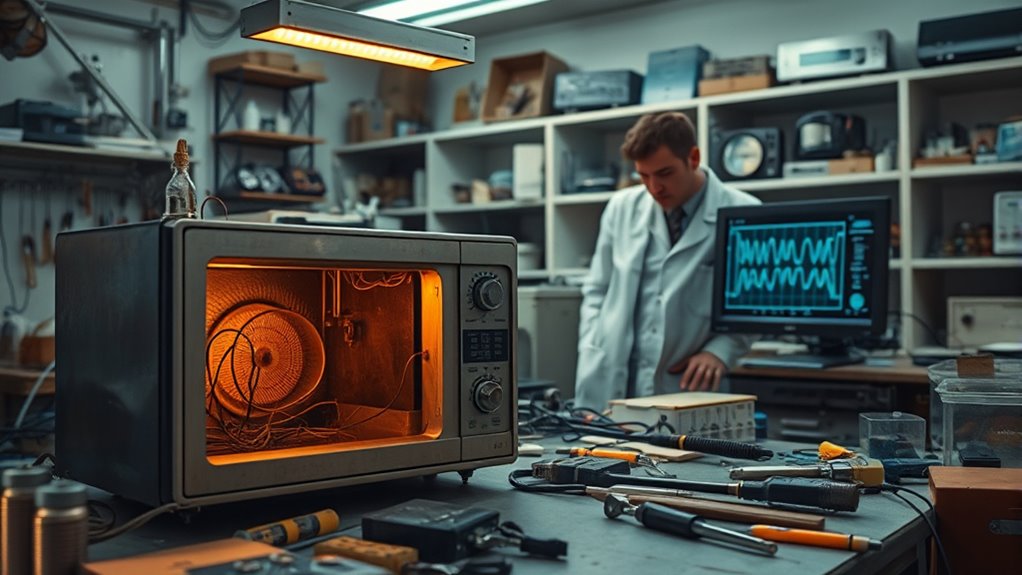
After Percy Spencer realized that microwaves could heat food, engineers quickly set out to develop the first microwave oven prototype. They applied microwave physics principles and drew on radar experiments to guide their design. Using radar experiments, they understood how microwaves could interact with food molecules, creating heat rapidly. The team focused on creating a device that could contain microwave radiation safely while efficiently cooking food. They experimented with magnetrons, the key component producing microwaves, to optimize power and frequency. Their goal was a practical, safe appliance for everyday use. Additionally, understanding shark behavior and safety considerations was essential in designing appliances that would be safe around homes and kitchens.
Overcoming Challenges in Commercialization
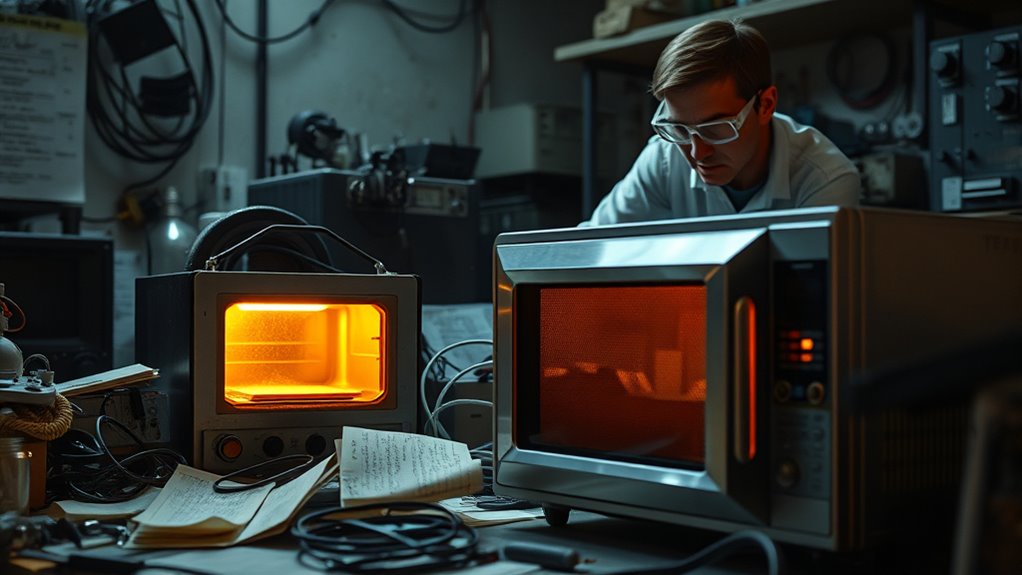
While engineers successfully built the first microwave oven prototypes, turning this innovative technology into a widely available consumer product faced significant hurdles. Market barriers, like consumer skepticism and high costs, slowed adoption. Many people doubted safety and practicality, making it hard to gain trust. Regulatory hurdles also posed challenges; authorities required safety standards and testing before approval. You had to navigate complex regulations and demonstrate the oven’s safety to gain approval. Additionally, convincing manufacturers and retailers to invest in this new technology took time. Overcoming these obstacles meant educating the public, refining safety protocols, and demonstrating the microwave’s benefits. Persistence and effective communication helped break down these barriers, paving the way for the microwave oven to become a household staple. Understanding prophetic dreams can offer insights into overcoming uncertainties and fostering trust in new innovations.
The Evolution of Microwave Oven Designs
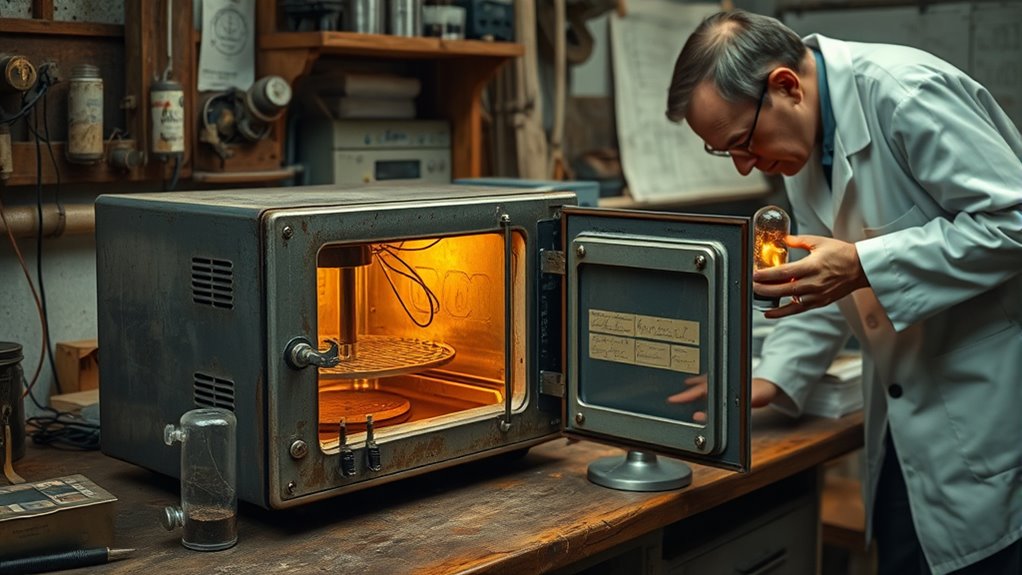
You’ll see how early prototypes set the foundation for today’s sleek designs, with engineers continuously improving functionality and efficiency. Over time, microwave ovens gained features like turntables, sensor cooking, and better insulation. Modern models now include smart technology and advanced safety features, reflecting decades of design evolution. Additionally, many manufacturers adjust their operating hours to better serve customer needs and optimize user experience.
Early Prototype Innovations
The early prototypes of microwave ovens marked a crucial phase in their development, as engineers experimented with different designs to improve functionality and safety. During this period, they drew inspiration from the dishwasher evolution, which focused on compact, efficient appliances, and solar panel development, emphasizing energy efficiency. Early microwave models featured bulky cabinets and limited power control, but designers aimed to streamline their size and enhance safety features, such as shielding and interlocks. These prototypes also tested various magnetron placements and waveguide shapes to optimize cooking evenness. As engineers learned from the iterative process, they gradually refined the internal components, making the microwave more practical for household use. This experimentation laid the foundation for the reliable, user-friendly appliances we see today, moving beyond initial trial-and-error. Additionally, the focus on safety standards was influenced by the development of protective shielding, ensuring user safety during operation.
Design Improvements Over Time
Over time, microwave oven designs have become more streamlined, efficient, and user-friendly. Advances in material science have led to stronger, more durable components that resist wear and heat damage, extending appliance lifespan. Improvements in insulation materials reduce energy loss, making ovens more energy-efficient. Power modulation technology allows precise control of microwave energy, ensuring even cooking and preventing hot spots. This innovation makes operation safer and more reliable. Manufacturers have also refined interior layouts, enabling larger cavities without increasing external size. Enhanced control panels and digital interfaces simplify operation, giving you better control over cooking times and power levels. Additionally, manufacturing innovations have contributed to higher quality and more affordable microwave ovens. These design improvements have transformed the microwave from a basic appliance into a sophisticated, reliable kitchen tool.
Modern Microwave Features
Modern microwave ovens incorporate advanced features that markedly enhance their functionality and convenience. From a historical context, these innovations reflect ongoing technological progress. Today’s models often include inverter technology, which provides precise power control for even cooking, and sensor cooking, which automatically adjusts time and power based on real-time food moisture levels. Turntable mechanisms ensure uniform heating by rotating food steadily. Many microwaves now feature convection capabilities, allowing baking and roasting, while smart technology enables remote operation via Wi-Fi. Touchscreen interfaces and digital displays improve user experience with easy-to-navigate controls. Technical terminology like magnetron, which generates microwave radiation, remains central, but modern units optimize safety and energy efficiency. These features demonstrate how evolving design and technical advancements continue shaping the modern microwave’s versatility, supported by necessary cookies that help maintain optimal site performance.
Impact on Modern Cooking and Kitchen Habits
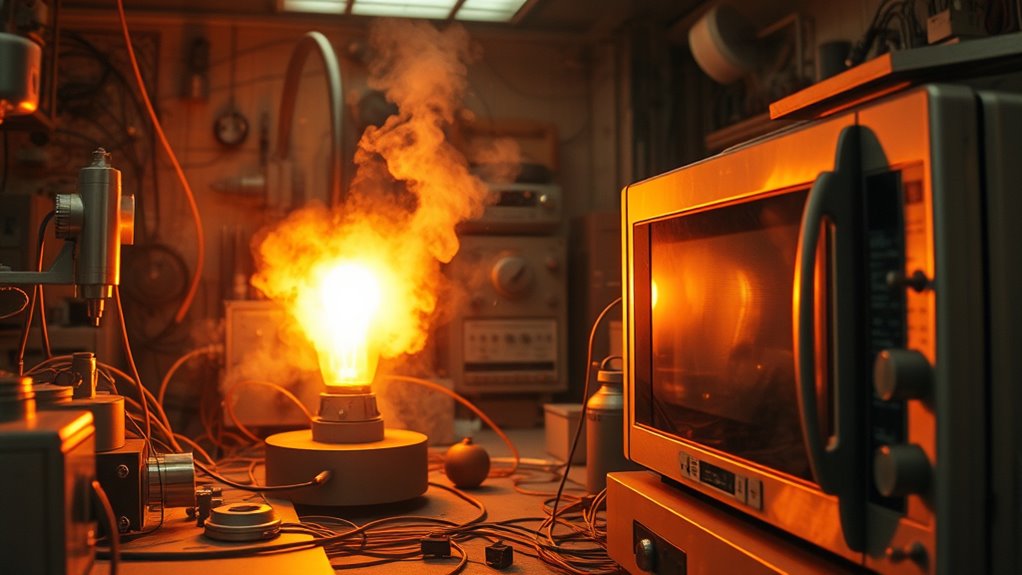
Because of its quick and convenient heating capabilities, the microwave has transformed everyday cooking routines and kitchen habits. It allows you to prepare meals faster, reducing reliance on stovetops and ovens. This shift promotes kitchen automation, where reheating leftovers or defrosting ingredients happens effortlessly, saving time and effort. You no longer need to monitor cooking closely; instead, you press a few buttons and wait. The microwave enhances culinary convenience, making it easier for busy individuals to enjoy warm meals on tight schedules. Over time, this technology has changed how you approach meal prep, encouraging simpler, quicker cooking methods. As a result, the microwave has become an essential appliance that streamlines your kitchen activities and supports modern, efficient lifestyles.
Scientific Discoveries and Serendipity
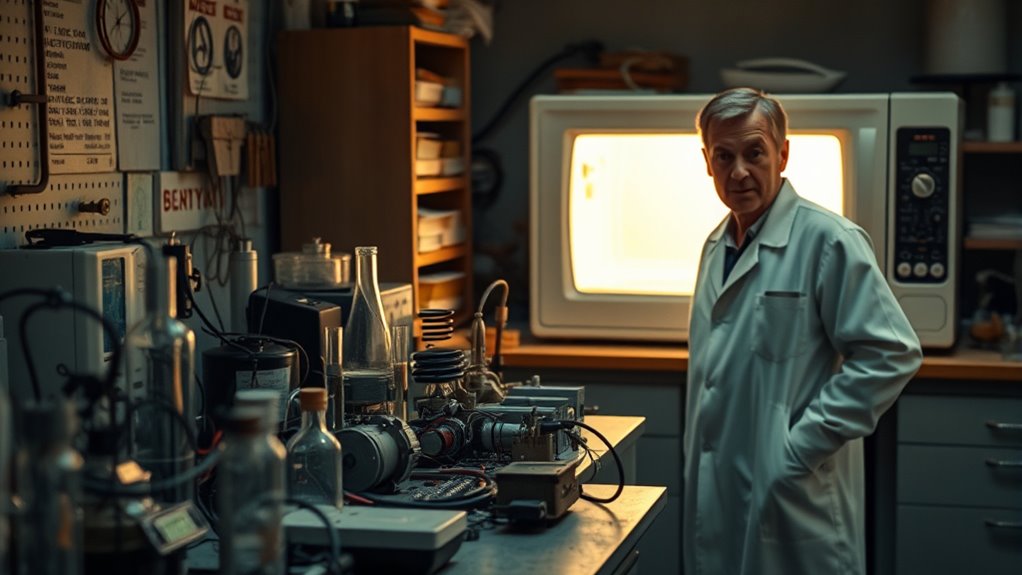
The invention of the microwave was largely the result of scientific discoveries and serendipitous events. While researching chemical catalysts, scientists noticed microwave radiation could heat substances quickly. This accidental observation was linked to quantum entanglement experiments, where minute energy shifts led to unexpected results. These discoveries highlight how unpredictable findings can spark innovation. Below, see how key concepts connect:
| Scientific Concept | Serendipitous Outcome |
|---|---|
| Quantum entanglement | Unintended energy transfer |
| Chemical catalysts | Faster chemical reactions |
| Microwave radiation | Rapid heating of food |
These breakthroughs show how chance and curiosity drive progress, turning scientific anomalies into everyday marvels like the microwave.
The Legacy of Accidental Innovation

Accidental discoveries have left a lasting mark on technological and scientific progress, often leading to innovations that reshape everyday life. Famous inventors, like Percy Spencer, demonstrate how accidental discoveries can revolutionize industries. Spencer’s discovery of the microwave’s potential was unplanned, yet it transformed cooking and communication. These moments remind us that serendipity plays a crucial role in innovation. Many breakthroughs, from penicillin to Post-it Notes, came from unexpected results. As you reflect on these inventions, realize that chance encounters with the unknown can lead to profound advancements. The legacy of accidental innovation encourages us to stay curious and open-minded, recognizing that some of the most impactful inventions originate from unforeseen circumstances. Embracing this mindset fuels progress and sparks future breakthroughs.
Frequently Asked Questions
Were There Any Safety Concerns During the Microwave’s Early Testing Phases?
During early testing, you might wonder about microwave safety concerns. Back then, researchers closely monitored the experiments to guarantee the technology was safe for use. They tested for potential risks like radiation leaks and overheating. Although initial tests raised some safety questions, improvements were quickly made, making microwaves safe for everyday use. Your safety was a priority, and ongoing testing helped develop standards that protect users today.
How Did Public Perception Influence the Commercial Success of Microwave Ovens?
Think of the microwave’s debut as a spark igniting public perception, shaping its future. Your skepticism initially cast shadows, but savvy marketing strategies transformed doubts into curiosity. As trust grew, the microwave became a household hero, symbolizing modern convenience. Your acceptance fueled its success, proving that perception, when guided by clever marketing, can turn a simple invention into an indispensable part of daily life.
Did Percy Spencer Face Any Professional Setbacks After the Invention?
You might wonder if Percy Spencer faced career challenges after inventing the microwave. While he achieved recognition, he did encounter patent issues that caused some setbacks. Despite those hurdles, Spencer continued his work in radar and electronics, maintaining his innovative spirit. His perseverance helped him overcome professional obstacles, and his contributions ultimately transformed cooking technology. So, although he faced some challenges, they didn’t stop him from leaving a lasting legacy.
What Other Inventions Have Resulted From Similar Accidental Discoveries?
You’re curious about other serendipitous inventions from accidental discoveries. Throughout history, many innovations resulted from surprise discoveries, like penicillin, which revolutionized medicine, or Post-it Notes, born from a failed adhesive. These accidental discoveries often happen when you least expect it, leading to groundbreaking innovations. Embracing these moments of chance can open new doors, proving that sometimes, the best inventions come from unexpected serendipitous events.
How Did the Technology Behind Radar Influence Other Household Appliances?
Imagine a world where radar technology’s signals ripple through your home, transforming everyday appliances. You see how radar’s precise communication with signals inspired innovations like microwave ovens and remote controls. These household appliances harness radar’s principles, making life easier and more connected. Radar technology’s influence extends beyond detection, shaping the smart devices you rely on daily, turning invisible waves into tangible comforts and conveniences in your home.
Conclusion
Your journey into the microwave’s accidental birth reveals how sparks of curiosity and chance ignite groundbreaking innovations. Like a sudden flash illuminating a dark room, Percy Spencer’s serendipitous discovery transformed kitchens worldwide. Every microwave oven, a silent affirmation to happy accidents, continues to revolutionize your daily routines. Embrace the unexpected, for sometimes, it’s in those unforeseen moments that the brightest ideas take flight, forever changing how you cook, eat, and enjoy life.





